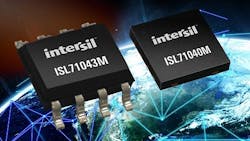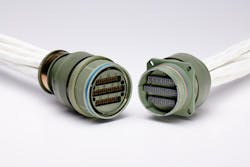2019 Military & Aerospace Technology Innovators Awards announced for aerospace and defense achievement
NASHUA, N.H. – Military & Aerospace Electronics and Intelligent Aerospace have announced their 2019 Technology Innovators Awards to recognize companies offering substantial military, aerospace, and avionics design solutions.
Awards are in three tiers -- ranging from platinum, the highest, to the gold awards, and finally to the silver awards -- and are based on the recommendations of an independent panel of industry judges.
Platinum awards
The ISL7104xM plastic-packaged, radiation-tolerant pulse-width modulator (PWM) controller and gallium nitride (GaN) field-effect transistor (FET) driver for new space small satellites from Renesas Electronics America Inc. in Milpitas, Calif., are for use in power supplies in satellites operating in low Earth orbit. These characteristics include inherent radiation tolerance, plastic packaging, small die size, no parasitic p-n diode and fast switching, increased efficiency, and small total size.
The SGRB series DC-DC converter from VPT Inc. in Blacksburg, Va., is a commercially available GaN-based, space-qualified line of DC-DC converters that is radiation tolerant and achieves high efficiency to 95 percent. It is for applications facing the harsh radiation environments of space, and includes a fixed-frequency reduced voltage switching topology for low input and output noise. This makes it well-suited for space-borne telecommunications where high efficiency, low noise, and radiation tolerance are imperative.
The 7 series microwave and RF Assemblies from W. L. Gore & Associates in Newark, Del., are engineered to prevent the ingress of water vapor, fuels, oils, chemicals, and other hazardous contaminants commonly found in airborne environments. With their rugged, vapor-sealed construction, these assemblies maintain low insertion loss, low return loss, and phase stability at frequencies to 18 GHz, while providing shielding effectiveness in challenging aerospace environments.
The 1.8-millimeter simplex aerospace fiber optic cables from W. L. Gore & Associates help provide weight and cost savings over the life of an aircraft, while meeting the rigorous demands of in-flight operation. These optical fibers deliver signal integrity for high-speed data transmission in a wide range of temperatures, and resist crushing, kinking, and abrasion to handle complex routing, maintenance activities, and repeated flight conditions. The cables also have a compact, flexible footprint with installed robustness that meets size, weight and routing constraints as more high-tech avionics are being installed or retrofitted into civil aircraft.
The Multi-Modal Sensor Pod (MMSP) from Logos Technologies LLC in Fairfax, Va., combines Wide-area motion imagery (WAMI), hyperspectral, and high-definition spotter sensors in one compact, lightweight package. The persistent-surveillance sensor also includes 15-plus times the normal coverage of hyperspectral imaging; high-definition spotter; automatic cross-cueing between sensors; multiple, in-flight ground scanning options;; a small onboard multi-modal edge processor with extremely high data digestion rates; and the ability to display different data streams in its user interface.
The RFT-3200 microwave downconverter with dynamically adjustable IF from Mercury Systems in Andover, Mass., uses a dynamically adjustable IF architecture to enable users to set the IF frequency and bandwidth in real-time to achieve mission-to-mission optimization and compatibility with a wide-range of digitizers. The RFT-3200 also offers wide band performance with RF to 40 GHz and IBW to 2 GHz for circumstances that require processing emerging threats that exceed the frequency limitations of standard RF hardware. Additionally the RFT-3200 supports industry-leading phase noise, phase coherent operation, and multiple configuration options.
Space Active Optical Cable (SAOC) from AirBorn Inc. in Georgetown, Texas, is screened for reliability. Compared to traditional fiber optics or traditional active optical cables, the SAOC is a rugged solution that can withstand g-forces of launch, radiation in space, and quickly can be installed. There are no fiber cleaning concerns with AirBorn's AOC because the solution uses a traditional copper electrical interconnect. This allows the technology to quickly be deployed on the battlefield to bring high speed applications to life.
The Helix Virtualization Platform from Wind River Systems in Alameda, Calif., Wind River Helix Virtualization Platform is a software-development tool based on a certifiable Type-1 hypervisor that enables applications with different levels of criticality to run simultaneously on one multi-core system. In addition to the VxWorks real-time operating system, the Helix Platform comes with Wind River Linux and Simics for turn-key application development. The tool follows standard APIs such as ARINC 653 APEX API, FACE, POSIX, and VxWorks, and supports unmodified guest operating systems, OS-agnostic virtualization, and separation technology.
The HUNTR TDL hub and network translator from the Curtiss-Wright Corp. Defense Solutions division in Ashburn, Va., enables joint terminal attack controllers (JTACs) and Tactical Air Control Parties (TACPs) to create a multi-tactical datalink network that supports SADL, Link 16, Cursor on Target, and VMF Combat Net Radio (CNR) data exchanges among ground forces, aircraft, ships, and command-and-control elements. This software application improves and simplifies the real-time translation and routing of tactical data links, and provides warfighters and command and control centers with real-time access to operational data in the field.
The Connext DDS Secure data-centric connectivity framework enables military and aerospace system architects to build secure and scalable systems of systems. It uses decentralized, peer-to-peer connectivity to support fine-grained security, high performance and reliability requirements, and helps deliver authentication, access control, encryption, data tagging, and logging of security events. These capabilities enable users to choose between non-secured, signed and encrypted topics to meet military and aerospace performance needs. Connext DDS Secure applies data security at the software application level so that it is independent of the underlying network type and protocol.
Gold awards
The Orion 32-inch rugged 4K display from ZMicro in San Diego offers the ability to integrate a variety of video sources on one display; small size, weight, and power consumption (SWaP); and improved visibility in degraded visual environments. The Orion 32 can consolidate video inputs from as many as five sources and display streams using Virtual Windows that project each video stream to a dedicated window of any size or location or order on the display. Virtual Windows can switch dynamically to a new size and or location. The Orion 32 4K display offers efficient use of pixels, and its 3840-by-2160-pixel display is equivalent to four full HD displays.
The ATS-3100 VRS tactical radio test and measurement set from Astronics Test Systems in Irvine, Calif., is built on a modular platform, and addresses any tactical radio: legacy, present, and future. It is a suitable replacement for the AN/GRM-122. The company's TPS process can help users develop, deploy, and maintain the TPS according to these supplier prerequisites, including their individual and proprietary best practices for tactical radio test. Its open architecture offers long-term sustainability.
The military-grade high-density 16-gigabyte DDR4 from Mercury Systems in Andover, Mass., is a high density double data rate fourth-generation synchronous dynamic random-access memory (DDR4 SDRAM) device that comes in a 16-by-23-millimeter ball grid array (BGA) package that offers an 87 percent circuit board savings compared to commercial memory. The product was designed using a new advanced design technology that doubles the number of the devices embedded in a package without compromising performance or reliability. Conventional three-dimensional packaging technologies embed multiple memory devices to meet the processing demands of space-constrained military systems.
The ZE-VC rugged small-form-factor embedded video capture computer from ZMicro in San Diego is for airborne intelligence, surveillance, and reconnaissance (ISR) applications. It integrates an 8th Generation Intel Core i7 processor to deliver quad core performance with maximum turbo frequency of 4.20 Ghz. It includes the Blackmagic Decklink Duo 2 PCI Express capture and playback card, and features four independent 3G-SDI connections that support SDI formats in SD and HD resolution as fine as 1080 pixels to provide the flexibility of four separate cards in one. At the heart of the ZE-VC is the Intel NUC board, a 4-by-4-inch commercial motherboard that provides the processor, memory, graphics, storage, peripheral interfaces, LAN, and expansion capabilities.
The D-Frame OpenVPX development platform from Elma Electronic in Alameda, Calif., is a development chassis is for OpenVPX and SOSA-aligned board and system design. It helps design systems for use in critical defense applications. Designed for low-slot-count payloads, the D-Frame can be configured to the exact board count required. In addition, suppliers have developed backplane products targeting these lower slot count applications and so off the shelf backplanes may be used in the D-Frame without wasting space for ten or more unused slots. Secure hatch locking screws ensure a tight reliable fit and a carrying handle completes a clean and professional briefcase look.
The TGA2222 32-to-38 GHz 10-Watt GaN amplifier from Qorvo Inc. in Greensboro, N.C., is a wide band power amplifier monolithic microwave integrated circuit (MMIC) that provides 40 dBm (10 W) of saturated output power and 16 dB of large signal gain while achieving better than 22 percent power-added efficiency. Built on Qorvo’s gallium nitride on silicon carbide (GaN-on-SiC) technology, the TGA2222 delivers this extended RF power in a smaller die, which reduces size, weight, and number of components to create a simple but powerful solution for radar and electronic warfare (EW) applications.
The V3-1703 NXP Layerscape LS1043A Quad A53 single-board computer from Curtiss-Wright Defense Solutions is an Arm-based, safety-certifiable single board computer with an NXP Layerscape LS1043A quad-core processor that delivers Arm’s performance per Watt to optimize performance and SWaP. Arm processors, like the V3-1703’s LS1043A, deliver the best power-to-performance ratio compared to Intel and Power Architecture processors, allowing the V3-1703 to balance performance requirements with power consumption constraints. Deterministic, non-throttling performance: like Power Architecture processors (and unlike Intel processors), the V3-1703’s Arm processor delivers deterministic, dependable performance in extreme temperatures.
The ZX1C 18 - Airborne Server from ZMicro features an 18-inch short-depth chassis and weighs less than 13 pounds to offer a small, light form factor that can accommodate small ISR aircraft without compromising server performance. The ZX1C 18 uses carbon fiber materials, which are stronger than steel and a fraction of the weight. It has a modified 750-Watt DC power supply, lightweight support brackets, and integrates ZMicro’s TranzPak 1 removable data storage modules which use M.2 NVMe solid-state drives and are much smaller than traditional 2.5-inch drives and about four times faster than SATA-3 solutions. The server meets full MIL-SPEC compliance for shock, vibration, temperature, EMI/EMC, and altitude specifications. It is certified for MIL-STD-461F, DO-160G, and MIL-STD-810G.
Silver awards
The MACHFORCE D38999-style high-speed 10G data connector from The Angelus Corp. in Sussex, Wis., is designed for rugged aerospace and defense applications. It offers ten 10G Ethernet ports; anti-decoupling ring for easy connect and disconnect with a gloved hand; and quick termination and field repairable with quick access to terminated wires. The high speed module has a unique rectangular pin configuration that maximizes shell size density and increases the amount of data transmitted per connector. It offers continuous signal integrity through impedance control and data pair isolation. Its aluminum fins allow for twisted pairs to be packed in closer to maximize shell data density, while protecting signal integrity and proper application performance. The connector’s optimized electrical performance allows for as many as five disconnects.
The Raven-Strike rugged, embedded computer from Systel Inc. in Sugar Land, Texas, is for modern fighting vehicles. It is a line replaceable unit designed for centralized ingest and data fusion of all vehicle sensors. This allows for the ability to collect, process, exploit, and disseminate critical data seamlessly at near real-time speeds. Raven-Strike acts as an autonomous-enabling hardware backbone, supporting the use of Artificial Intelligence (AI) and Deep Learning (DL) to shift the workload from man to machine and optimize and enable critical combat capabilities. Raven-Strike features dual Intel Xeon scalable processors and an NVIDIA GPGPU for edge computing performance in a highly contested, forward-deployed environment.
The EnsembleSeries HDS6605 OpenVPX AI processing blade from Mercury Systems is for artificial intelligence (AI) and other compute-intensive general processing workloads in sensor fusion, complex command and control, and deep-learning applications. Second-generation Intel Xeon Scalable processors feature Intel Deep Learning Boost, which extends Intel Advanced Vector Extensions-512 (AVX-512) to accelerate inference applications like speech recognition, image recognition, language translation, and ject detection, and more. As many as four HDS6605 blades can be clustered via Intel’s new ultrapath interconnect (UPI) for a truly integrated, low-latency non-uniform memory access (NUMA) server architecture that solves complex mission compute problems in real-time.
The Unattended Network Storage (UNS) rugged network-attached storage from Curtiss-Wright Defense Solutions helps prevent unauthorized access to classified information if the unattended platform is lost or stolen. It uses a DAR Type-1 encryptor that is planned to be certified for unattended operations of classified data Top Secret and below. Designed for high-speed data storage, the UNS combines more than 2 gigabyte-per-second data transfers with 32 terabytes of encrypted data storage on a rugged removable storage module (RSM). The RSMs ease the transport of data-at-rest between unmanned platforms and base stations for post-mission analysis. The encryptor uses Pre-Placed Keys (PPK) that are filled in Black Key format. The use of symmetric PPKs enables the same key to be loaded onto multiple encryptors so that data can be encrypted onto an RSM in one location for decrypting later at another location.
The TTC nREC-7000 10 Gigabit Ethernet airborne network flight test recorder from Curtiss-Wright Defense Solutions is a small data recorder for aircraft with very limited room to install systems. It captures current and future high data rates, and can record at speeds as fast as 1,800 megabits per second. Captured data is stored in dual hot swappable RMM cartridges, supporting as much as 12 terabytes of data per recorder unit. It’s compact design and ability to operate in harsh environments makes it suitable for demanding applications requiring high speed recording such as flight test and high-speed camera data acquisition.
The MPU5 mobile ad hoc networking (MANET) radio from Persistent Systems LLC in New York City offers a scalable Wave Relay MANET that can keep adding hundreds of nodes without collapsing under the weight of routing protocols. It also doesn't require external infrastructure or a vulnerable master node, so it is peer-to-peer and doesn't run into the video transmission hiccups or reconfiguration demands when nodes join and leave the network. The MPU5 offers The ability to tie together multiple, geographically dispersed MANET bubbles via 4G or Satcom, and has field-swappable RF band modules that allow the MPU5 to switch to different frequency ranges on the fly, giving users unparalleled flexibility. It is an integrated radio-over-IP (RoIP) capability, which via a simple tether, pulls third party legacy radios into the Wave Relay network without requiring a non-rugged vocality box, extra power, and configuration management overhead.
The Type E37 all-metal dual concentric encoder from Elma Electronic comes standard with either IP60 or IP68 front panel sealing and meets MIL-STD-202G for electrical, shock, and vibration. These features provide critical ruggedness for defense applications with a long life. The dual concentric design takes up the same geography as a single encoder for use in small, crowded or space-limited applications. Available in standard resolutions of with 16 or 32 detents, the outer and inner shafts each have selectable resolution options and a variety of selectable turning torques. Push-button torques of up to 14N are standard. Standard rotational life ratings are up to 1M revolutions; vertical and horizontal PCB orientations are standard. Routine applications include avionics data communications, navigation controls, inter/intra aircraft intercom systems and two-way radios.
The RVG-MS1 multi-sensor rugged video gateway from Curtiss-Wright Defense Solutions provides a low latency video processing and distribution system that enables the operator to select from a range of operational views, with the touch of a button, via an on-screen graphical user interface (GUI). This rugged COTS-based video management solution is designed to increase warfighter effectiveness and help drive mission success, The range of image configuration options include flexible picture in picture (PiP) and window overlays, while video streaming and blending capabilities provide additional end-user functionality. Furthermore, the RVG-MS1 acts as an Ethernet gateway, facilitating streaming video off platforms built to the latest vehicle architectures, such as VICTORY or GVA.
The coherent, multi-channel, direct digitization system from Mercury Systems supports rapid channel count scaling through adoption of the OpenVPX standard at the board level. This allows for easy configuration simply by selecting the specific COTS modules for a given application. By incorporating Mercury’s industry-leading COTS hardware, the data rates, bandwidths, and number of channels can be easily optimized for your specific application. Standard features include direct digitization to L-band, full coherency, and a scalable channel count. In order to provide maximum pulse edge alignment, the system uses a proprietary algorithm that accounts for any hardware-level timing variation. The system is also fully compatible with Mercury’s OpenVPX microwave transceivers to provide spectrum superiority across the standard electronic warfare bands.
The Elma Open System (ELOS) CompactPCI Serial system from Elma Electronic is a small-form-factor modular computing platform for rugged defense and rail transportation applications. The ELOS extensible chassis and internal building blocks allow for a range of system configurations. Respectable data rates of 12 gigabits per second serve as a nice performance mid-range solution for many defense applications which require higher signal speeds compared to VME and CompactPCI but less than that supported by OpenVPX. System designers faced with technology roadblocks due to the limited capabilities of VME and CompactPCI may now apply their Eurocard architecture experience in switching to CompactPCI Serial.
Liquid Flow-Through Test & Development Platform for 6U OpenVPX Cards from Elma Electronic is for increasingly power-hungry 6U OpenVPX modules that require ambitious cooling. Most test and development platforms are designed only to accommodate standard, air-cooled card modules. This often means that two sets of boards must be purchased: one air-cooled set for lab testing and development, and another set for final deployable unit testing. Elma's platform enables testing of deployable boards in a lab environment. Elma Electronic’s long-standing expertise in packaging solutions for extreme environments led to the creation of the VITA 48.4 LFT test and development chassis.



